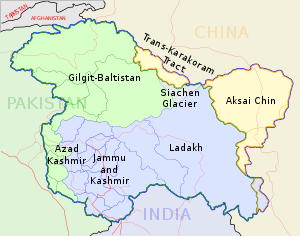
Back نزاع سياشن Arabic সিয়াচেন দ্বন্দ্ব Bengali/Bangla Conflicte de Siachen Catalan Siachen-Konflikt German Conflicto de Siachen Spanish درگیری سیاچن Persian Siachenin konflikti Finnish סכסוך סיאצ'ן HE सियाचिन विवाद Hindi Konflik Siachen ID
| Siachen conflict | |||||||||
|---|---|---|---|---|---|---|---|---|---|
| Part of the Kashmir conflict | |||||||||
 Labelled map of the greater Kashmir region; the Siachen Glacier lies in the Karakoram Range and its snout is situated less than 50 km (31 mi) north of the Ladakh Range | |||||||||
| |||||||||
| Belligerents | |||||||||
|
|
| ||||||||
| Commanders and leaders | |||||||||
|
| ||||||||
| Strength | |||||||||
| 3,000+[4] | 3,000[4] | ||||||||
| Casualties and losses | |||||||||
The Siachen conflict, sometimes referred to as the Siachen Glacier conflict or the Siachen War, was a military conflict between India and Pakistan over the disputed 1,000-square-mile (2,600 km2)[12] Siachen Glacier region in Kashmir. The conflict was started in 1984 by India's successful capture of the Siachen Glacier as part of Operation Meghdoot, and continued with Operation Rajiv in 1987. India took control of the 70-kilometre-long (43 mi) Siachen Glacier and its tributary glaciers, as well as all the main passes and heights of the Saltoro Ridge immediately west of the glacier, including Sia La, Bilafond La, and Gyong La. Pakistan controls the glacial valleys immediately west of the Saltoro Ridge.[13][14][page needed] A cease-fire went into effect in 2003,[15] but both sides maintain a heavy military presence in the area. The conflict has resulted in thousands of deaths, mostly due to natural hazards.[16] External commentators have characterized it as pointless, given the perceived uselessness of the territory, and indicative of bitter stubbornness on both sides.[16]
- ^ Baruah, Amit. "India, Pak. ceasefire comes into being". The Hindu. 26 November 2003. Archived from the original on 24 November 2016. Retrieved 21 April 2018.
{{cite news}}: CS1 maint: location (link) - ^ P. Hoontrakul; C. Balding; R. Marwah, eds. (2014). The Global Rise of Asian Transformation: Trends and Developments in Economic Growth Dynamics (illustrated ed.). Springer. p. 37. ISBN 9781137412362. Archived from the original on 7 February 2023. Retrieved 21 April 2018.
Siachen conflict (1984—2003)
Victorious: India / Defeated: Pakistan - ^ Cite error: The named reference
:1was invoked but never defined (see the help page). - ^ a b "War at the Top of the World". Time.com. 7 November 2005. Archived from the original on 12 April 2012. Retrieved 11 October 2011.
- ^ "Army chief to visit Siachen this week". The Times of India. 8 January 2020. Archived from the original on 8 January 2020. Retrieved 8 January 2020.
- ^ a b The Illustrated Weekly of India – Volume 110, Issues 14–26. Times of India.
Pakistani troops were forced out with over 200 casualties as against 36 Indian fatalities
- ^ "Defence Minister Rajnath Singh Bonds With Soldiers At Siachen Over Jalebi". NDTV. 4 June 2019. Archived from the original on 12 August 2019. Retrieved 4 June 2019.
- ^ "Rajnath Singh visits Siachen to review security situation, pays tribute to martyrs - PICS". Times Now News. 3 June 2019. Archived from the original on 7 June 2019. Retrieved 4 June 2019.
Rajnath Singh also paid tribute to the martyred soldiers who sacrificed their lives while serving in Siachen. He went on to say, "More than 1,100 soldiers have made supreme sacrifice defending the Siachen glacier. The nation will always remain indebted to their service and sacrifice."
- ^ 846 Indian soldiers have died in Siachen since 1984 – Rediff.com News Archived 12 September 2012 at the Wayback Machine. Rediff.com. Retrieved on 12 July 2013.
- ^ "Six dead after avalanche hits Army positions in Northern Siachen". The Times of India (TOI). 19 November 2019. Archived from the original on 20 November 2019. Retrieved 22 November 2019.
- ^ "In Siachen 869 army men died battling the elements". The Hindu. Archived from the original on 19 February 2016. Retrieved 12 December 2015.
- ^ Desmond, Edward W. (31 July 1989). "The Himalayas War at the Top Of the World". Archived from the original on 14 January 2009. Retrieved 11 October 2008 – via www.time.com.
- ^ Wirsing, Robert (15 November 1991). Pakistan's security under Zia, 1977–1988: the policy imperatives of a peripheral Asian state. Palgrave Macmillan, 1991. ISBN 9780312060671.
- ^ Child, Greg (1998). Thin air: encounters in the Himalayas. The Mountaineers Books, 1998. ISBN 9780898865882.[page needed]
- ^ Watson, Paul (26 November 2003). "India and Pakistan Agree to Cease-Fire in Kashmir". Los Angeles Times. Archived from the original on 27 April 2017. Retrieved 27 April 2017.
- ^ a b Wilkinson, Freddie (18 February 2021). "How a tiny line on a map led to conflict in the Himalaya". National Geographic. Archived from the original on 19 November 2021. Retrieved 19 November 2021.
© MMXXIII Rich X Search. We shall prevail. All rights reserved. Rich X Search